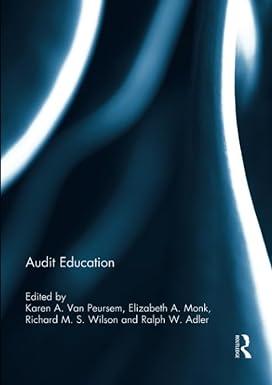Question
Case study: 'Got away lightly': Barclays CEO fined $1.1m after trying to expose whistleblower Barclays' chief executive officer Jes Staley was fined 642,430 pounds ($1.1
Case study:
'Got away lightly': Barclays CEO fined $1.1m after trying to expose whistleblower
Barclays' chief executive officer Jes Staley was fined 642,430 pounds ($1.1 million) by British regulators for his attempts to uncover a whistleblower.
"Mr. Staley breached the standard of care required and expected of a chief executive in a way that risked undermining confidence in Barclays' whistle-blowing procedures," Mark Steward, executive director of enforcement and market oversight at the Financial Conduct Authority, said in an emailed statement Friday.
"Whistleblowers play a vital role in exposing poor practice and misconduct in the financial services sector."
The fine is the third-biggest ever imposed by the FCA on an individual. Last month, the regulator indicated it would stop short of the more serious accusation of acting with a lack of integrity, which would have cost Staley his job. Compliance professionals were split on whether Staley, who retains the support of his board, got away with the equivalent of a slap on the wrist.
"In terms of the level of the fine, he did indeed get away lightly," said Tom Kirchmaier, professor of governance at Copenhagen Business School.
"He would have known that this is very much not what is expected from a CEO, and so the fine is not much more than a very light warning."
The fine is equivalent to about 15 percent of his reported 2016 compensation, according to data compiled by Bloomberg. Barclays, in a separate statement, said it cut Staley's 2016 bonus by 500,000 pounds. "I have consistently acknowledged that my personal involvement in this matter was inappropriate," Staley said.
The FCA and Prudential Regulation Authority also said Barclays's whistle-blowing systems and controls will be subject to "enhanced monitoring and scrutiny," the first time such measures have been imposed on a financial firm.
The scandal has been the first test of the FCA's Senior Managers and Certification Regime, which requires officials to be directly accountable for misconduct on their watch. Regulators have placed whistle-blowing, and the protection of those raising the alarm, at the heart of efforts to avoid misconduct and scandals since the financial crisis.
"A CEO should set an example for the firm's employees. Clearly, Mr. Staley has failed in this regard," said Nicky Morgan, a UK lawmaker and chair of Parliament's Treasury Committee, which frequently grills financial industry leaders after scandals. "In our next evidence session with the FCA, we'll ask why it believes that the fines are appropriate."
The whistle-blowing controversy dates back to June 2016, when Barclays's board received an anonymous letter raising concerns about the recruitment of one of Staley's former colleagues at JPMorgan Chase, Tim Main. The contact flagged issues of a personal nature regarding Main and Staley's role in dealing with those concerns at JPMorgan.
After learning about the matter, Staley twice attempted to identify the whistle-blower, despite being informed that it was inappropriate for him to do so. Barclays's own investigation had found Staley "honestly, but mistakenly, believed" his actions were permitted.
Staley agreed to settle at an early stage of the investigation, qualifying for a 30 percent reduction to the combined FCA and PRA fine, the regulators said.
Using the news article provided below as a base, and referring to other appropriate literature, discuss and critically evaluate the following: 1. Describe an accounting theory that may help to explain the CEOs conduct leading to the whistleblowing. Critically link that theory with CEOsbehaviour. 2. Using a second accounting theory, explain how your chosen theory may apply to whistleblowing. How is this theory related to whistleblower behavior
3. Using a third accounting theory, explain the regulators quest to make the CEO accountable.
4. Compare, contrast and critically evaluate the three theories you have chosen.
Step by Step Solution
There are 3 Steps involved in it
Step: 1

Get Instant Access to Expert-Tailored Solutions
See step-by-step solutions with expert insights and AI powered tools for academic success
Step: 2

Step: 3

Ace Your Homework with AI
Get the answers you need in no time with our AI-driven, step-by-step assistance
Get Started


